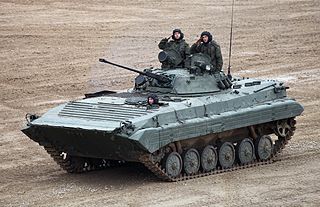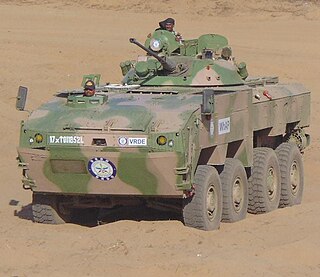Related Research Articles

The BMP-2 is an amphibious infantry fighting vehicle introduced in the 1980s in the Soviet Union, following on from the BMP-1 of the 1960s.

The Arjun is a third generation main battle tank developed by the Combat Vehicles Research and Development Establishment (CVRDE) of the Defence Research and Development Organisation (DRDO), for the Indian Army. The tank is named after Arjuna, the archer prince who is the main protagonist of the Indian epic poem Mahabharata. Design work began in 1986 and was finished in 1996. The Arjun main battle tank entered service with the Indian Army in 2004. The 43rd Armoured Regiment, formed in 2009, was the first regiment to receive the Arjun.

The Defence Research and Development Organisation (DRDO) is an agency under the Department of Defence Research and Development in Ministry of Defence of the Government of India, charged with the military's research and development, headquartered in Delhi, India. It was formed in 1958 by the merger of the Technical Development Establishment and the Directorate of Technical Development and Production of the Indian Ordnance Factories with the Defence Science Organisation under the administration of Jawaharlal Nehru. Subsequently, Defence Research & Development Service (DRDS) was constituted in 1979 as a service of Group 'A' Officers / Scientists directly under the administrative control of the Ministry of Defence.

Pinaka is a multiple rocket launcher produced in India and developed by the Defence Research and Development Organisation (DRDO) for the Indian Army. The system has a maximum range of 40 km for Mark-I and 60 km for Mark-I enhanced version, and can fire a salvo of 12 HE rockets in 44 seconds. The system is mounted on a Tatra truck for mobility. Pinaka saw service during the Kargil War, where it was successful in neutralising Pakistani positions on the mountain tops. It has since been inducted into the Indian Army in large numbers.

The GTRE GTX-35VS Kaveri is an afterburning turbofan project under development by the Gas Turbine Research Establishment (GTRE), a lab under the Defence Research and Development Organisation (DRDO) in Bengaluru, India. An Indian design, the Kaveri was originally intended to power production models of the HAL Tejas Light Combat Aircraft (LCA) developed by Hindustan Aeronautics Limited. However, the Kaveri programme failed to satisfy the necessary technical requirements on time and was officially delinked from the Tejas programme in September 2008.
In India, the Armament Research & Development Establishment (ARDE) is a laboratory of the Defence Research and Development Organisation (DRDO). Located in Pune, it is the main DRDO lab involved in the development of conventional armaments.

The DRDO Nishant - is an unmanned aerial vehicle (UAV) developed by India's Aeronautical Development Establishment (ADE), a branch of Defence Research and Development Organisation (DRDO) for the Indian Armed Forces. The Nishant UAV is primarily tasked with intelligence gathering over enemy territory and also for reconnaissance, training, surveillance, target designation, artillery fire correction, damage assessment, ELINT and SIGINT. The UAV has an endurance of four hours and thirty minutes. Nishant has completed development phase and user trials.
Combat Vehicles Research and Development Establishment (CVRDE) is a laboratory of the Defence Research and Development Organisation (DRDO). Located at Avadi, in Chennai, India. It is the main DRDO lab involved in the development of Armoured fighting vehicles, Tanks, Automotive electronics and many other.

The Vijayanta was a main battle tank built in India based on a licensed design of the Vickers Mk.1. The Vijayanta was the first indigenous tank of the Indian Army.

Gas Turbine Research Establishment (GTRE) is a laboratory of the Defence Research and Development Organisation (DRDO). Located in Bengaluru, its primary function is research and development of aero gas-turbines for Military aircraft. As a spin-off effect, GTRE has been developing marine gas-turbines also.

The Indian Ballistic Missile Defence Programme is an initiative to develop and deploy a multi-layered ballistic missile defence system to protect India from ballistic missile attacks. It was launched in 2000 after the Kargil War by the Atal Bihari Vajpayee government. Testing was carried out and continuing as of 2006, and the system was expected to be operational within four years according to the head of the country's missiles development programme, Vijay Kumar Saraswat.

The Nag missile, also called "Prospina" for the land-attack version, is an Indian third-generation, all-weather, fire-and-forget, lock-on after launch, anti-tank guided missile (ATGM) with an operational range of 500 m to 20 km depending on variant. It has a single-shot hit probability of 90% and a ten-year, maintenance-free shelf life. The Nag has five variants under development: a land version, for a mast-mounted system; the helicopter-launched Nag (HELINA) also known as Dhruvastra; a "man-portable" version (MPATGM); an air-launched version which will replace the current imaging infra-red (IIR) to millimetric-wave (mmW) active radar homing seeker; and the Nag Missile Carrier (NAMICA) "tank buster", which is a modified BMP-2 infantry fighting vehicle (IFV) produced under license in India by Ordnance Factory Medak (OFMK).
Research & Development Establishment (Engineers) is a laboratory of the Defence Research & Development Organization (DRDO). Located in Pune, Maharashtra, India. its primary function is development of mobility equipment for Indian Army Corps of Engineers
Vehicle Research and Development Establishment (VRDE) is a laboratory of the Defence Research & Development Organization (DRDO) located at Vahannagar near Ahmednagar. Its primary function is research and development of various light tracked, wheeled and specialised vehicles for defence applications.

Abhay was an Infantry Combat Vehicle created under a tech-demonstration program started in India by the Defence Research and Development Organisation or DRDO. As its first IFV project, Abhay was designed to provide experience in the construction of AFV components to DRDO, serve as a replacement to India's vast BMP fleet used in its Mechanised Infantry Regiments, and serve as a test bed for weapons and systems to be used on future vehicles, as well as to be a reference for the designs of future vehicles.
India has studied, produced and used various strategic and tactical missile systems since its independence. Decades long projects have realised development of all types of missile systems including ballistic, cruise, anti-ship, air-defence, air-to-air and anti-missile systems. India is one of seven countries in the world with intercontinental ballistic missiles (ICBMs) and one of four countries with anti-ballistic missile systems. Since 2016, India has been a member of Missile Technology Control Regime (MTCR).
Ordnance Factory Medak (OFMK), previously called Ordnance Factory Project Medak (OFPM) while in its development stage, is a factory owned by Armoured Vehicles Nigam Limited, a company that manufactures armoured vehicles and was one of the 41 Indian ordnance factories under the erstwhile Ordnance Factories Board of the Ministry of Defence, controlled by Government of India.

The TATA Kestrel, also known as the IPMV , is a family of armoured personnel carriers developed by Tata Advanced Systems and the Defence Research and Development Organisation (DRDO). It was developed to replace Soviet-era BMP-1 and BMP-2 and APCs in service with the Indian Army.
This article consists of projects of the Defence Research and Development Organisation.
References
- 1 2 "DRDO lab exhibition showcases indigenously developed products". Times of India. Archived from the original on 3 January 2013. Retrieved 17 May 2021.
- ↑ "Research & Development Establishment (Engrs)". Research & Development Establishment (Engrs). Retrieved 17 May 2021.
- ↑ "Sakaal Times - R&DE(E) exhibition on Feb 4, 5". Archived from the original on 8 September 2012. Retrieved 18 February 2012.
{{cite web}}: CS1 maint: unfit URL (link) - 1 2 "DRDO". Archived from the original on 10 February 2012. Retrieved 18 February 2012.